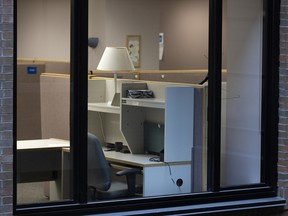WORKERS REVOLT
'Employees are not showing up': Return-to-office plans unravel as workers revolt in tight job marketWHITE, BLUE, PINK,
NO MATTER THE COLOUR OF YOUR COLLAR
WE ARE ALL PROLETARIANS NOW
Workers stubbornly sticking to remote work while struggling with child care, the grind of commuting and COVID worries
Bloomberg News
Matthew Boyle
Publishing date:May 13, 2022
At the same time, organizations that returned to the office in the first few months of the year now have loads of feedback from employees, many of whom are frustrated by commuting in just to spend half their day on Zoom calls. That adds to two full years of data on how workforces remained just as productive — and often were more satisfied — while working from home, and emerging research from academics. The result is a groundswell of hard evidence that can convince even the staunchest remote-work skeptics.
Examples of RTO resistance abound. At Apple Inc., a small group of employees has pushed back against the iPhone maker’s plan that will soon require most corporate workers to be in the office three days a week. A worker group called Apple Together penned an open letter to company leadership last month, in which signatories asked “to decide for ourselves, together with our teams and direct manager, what kind of work arrangement works best for each one of us.” The staffers also dismissed the oft-cited desire for in-person collaboration, saying “this is not something we need every week, often not even every month, definitely not every day.” Apple declined to comment.

A growing body of research supports these shifts. While many companies settled on three or four days in the office when initially establishing hybrid-work arrangements, the ideal setup is actually just one or two days in the office, according to a recent working paper from Harvard Business School. Hybrid work schedules can also reduce employee quit rates by 35 per cent compared with those who work entirely from the office, research co-led by Nicholas Bloom of Stanford University found. With Americans quitting jobs at a record pace — 4.5 million in March alone — that flexibility matters.

Workers stubbornly sticking to remote work while struggling with child care, the grind of commuting and COVID worries
Bloomberg News
Matthew Boyle
Publishing date:May 13, 2022

A person works in an office building in San Francisco.
PHOTO BY DAVID PAUL MORRIS/BLOOMBERG
Even the most inflexible bosses are softening their return-to-office expectations.
JPMorgan Chase & Co. chief Jamie Dimon has been one of the most vocal critics of remote work, arguing that it’s no substitute for the spontaneous idea generation that results from bumping into colleagues at the coffee machine. But in his annual letter to shareholders last month, the head of America’s biggest bank allowed that working from home “will become more permanent in American business,” and estimated that about 40 per cent of his 270,000-person workforce would work under a hybrid model, which includes days in the office and at home.
Soon after Dimon’s missive, one of the bank’s senior technology executives told some teams that they could cut back from three days in the office per week to two, citing internal feedback.
Many white-collar workplaces are making similar retreats as their employees stubbornly stick to working from home while struggling with child care, the grind of commuting and worries about rising COVID-19 cases. Bosses are wary of taking punitive action against those who aren’t following their ambitious so-called RTO plans, fearing it will backfire in today’s tight labour market. That leaves them to re-evaluate their carefully crafted strategies and reconsider what is a realistic long-term approach to in-person work.

Even the most inflexible bosses are softening their return-to-office expectations.
JPMorgan Chase & Co. chief Jamie Dimon has been one of the most vocal critics of remote work, arguing that it’s no substitute for the spontaneous idea generation that results from bumping into colleagues at the coffee machine. But in his annual letter to shareholders last month, the head of America’s biggest bank allowed that working from home “will become more permanent in American business,” and estimated that about 40 per cent of his 270,000-person workforce would work under a hybrid model, which includes days in the office and at home.
Soon after Dimon’s missive, one of the bank’s senior technology executives told some teams that they could cut back from three days in the office per week to two, citing internal feedback.
Many white-collar workplaces are making similar retreats as their employees stubbornly stick to working from home while struggling with child care, the grind of commuting and worries about rising COVID-19 cases. Bosses are wary of taking punitive action against those who aren’t following their ambitious so-called RTO plans, fearing it will backfire in today’s tight labour market. That leaves them to re-evaluate their carefully crafted strategies and reconsider what is a realistic long-term approach to in-person work.

A person is reflected in a window of a JPMorgan Chase & Co. bank branch across the street from the company’s headquarters in New York.
PHOTO BY MICHAEL NAGLE/BLOOMBERG
“We are seeing policies slip in real time,” said Melissa Swift, the U.S. transformation leader at workforce consultant Mercer. “There was previously all this talk about how, for white-collar jobs, collaborating in the office was important. That’s slipping. Now, only the people who need to turn a screwdriver need to be in the office.”
Not all workers are rebelling against directives to return the office, with variation across companies, sectors and job categories. Still, employers are seeing fresh reason to doubt the viability of their RTO guidelines. People are coming back to just about everything else — travel, restaurants, concerts, stores — amid a general loosening in state and federal COVID-related restrictions. So executives can no longer reassure themselves that workers would dutifully come back once those rules relaxed.
“We are seeing policies slip in real time,” said Melissa Swift, the U.S. transformation leader at workforce consultant Mercer. “There was previously all this talk about how, for white-collar jobs, collaborating in the office was important. That’s slipping. Now, only the people who need to turn a screwdriver need to be in the office.”
Not all workers are rebelling against directives to return the office, with variation across companies, sectors and job categories. Still, employers are seeing fresh reason to doubt the viability of their RTO guidelines. People are coming back to just about everything else — travel, restaurants, concerts, stores — amid a general loosening in state and federal COVID-related restrictions. So executives can no longer reassure themselves that workers would dutifully come back once those rules relaxed.
We are seeing policies slip in real timeMELISSA SWIFT
At the same time, organizations that returned to the office in the first few months of the year now have loads of feedback from employees, many of whom are frustrated by commuting in just to spend half their day on Zoom calls. That adds to two full years of data on how workforces remained just as productive — and often were more satisfied — while working from home, and emerging research from academics. The result is a groundswell of hard evidence that can convince even the staunchest remote-work skeptics.
Examples of RTO resistance abound. At Apple Inc., a small group of employees has pushed back against the iPhone maker’s plan that will soon require most corporate workers to be in the office three days a week. A worker group called Apple Together penned an open letter to company leadership last month, in which signatories asked “to decide for ourselves, together with our teams and direct manager, what kind of work arrangement works best for each one of us.” The staffers also dismissed the oft-cited desire for in-person collaboration, saying “this is not something we need every week, often not even every month, definitely not every day.” Apple declined to comment.

Some Apple workers are pushing back against plans to return to the office three days a week.
PHOTO BY MIKE BLAKE/REUTERS
For some companies, there’s no longer any debate. Airbnb Inc. had previously pegged September 2022 as its return to the office, but Chief Executive Officer Brian Chesky dumped that plan last month, instead telling his 6,000 employees that they could work remotely indefinitely. “Each of us works best in our own ways, and we’re giving you the flexibility to make the right choice based on where you’re most productive,” Chesky wrote in an email to staff.
A smattering of law firms have relaxed once-stringent attendance policies. Cooley LLP, a 3,000-person firm, said last month that it would let its lawyers decide whether and when to go into its offices, provided their duties allow for remote work.
When old-school bankers and lawyers grudgingly accept the value of working from home, it’s a sign of how much things have changed. A new survey of real-estate executives by CBRE Group Inc. found that the share of them who expect their workplaces to be “office-based” for most employees going forward declined to 19 per cent from 30 per cent last year. At the recent Milken Institute Global Conference, a popular icebreaker was asking fellow attendees about their organization’s work-from-home approach. “It’s as common a conversation opener as asking about someone’s kids,” said Bob Kricheff, a portfolio manager at Shenkman Capital Management.
For some companies, there’s no longer any debate. Airbnb Inc. had previously pegged September 2022 as its return to the office, but Chief Executive Officer Brian Chesky dumped that plan last month, instead telling his 6,000 employees that they could work remotely indefinitely. “Each of us works best in our own ways, and we’re giving you the flexibility to make the right choice based on where you’re most productive,” Chesky wrote in an email to staff.
A smattering of law firms have relaxed once-stringent attendance policies. Cooley LLP, a 3,000-person firm, said last month that it would let its lawyers decide whether and when to go into its offices, provided their duties allow for remote work.
When old-school bankers and lawyers grudgingly accept the value of working from home, it’s a sign of how much things have changed. A new survey of real-estate executives by CBRE Group Inc. found that the share of them who expect their workplaces to be “office-based” for most employees going forward declined to 19 per cent from 30 per cent last year. At the recent Milken Institute Global Conference, a popular icebreaker was asking fellow attendees about their organization’s work-from-home approach. “It’s as common a conversation opener as asking about someone’s kids,” said Bob Kricheff, a portfolio manager at Shenkman Capital Management.
A growing body of research supports these shifts. While many companies settled on three or four days in the office when initially establishing hybrid-work arrangements, the ideal setup is actually just one or two days in the office, according to a recent working paper from Harvard Business School. Hybrid work schedules can also reduce employee quit rates by 35 per cent compared with those who work entirely from the office, research co-led by Nicholas Bloom of Stanford University found. With Americans quitting jobs at a record pace — 4.5 million in March alone — that flexibility matters.

An empty office in Montreal.
PHOTO BY ALLEN MCINNIS/MONTREAL GAZETTE
When data-storage giant Teradata Corp. asked employees across all its U.S. locations if they wanted to come back to the office at least a few days a week, about half said yes, according to Chief People Officer Kathy Cullen-Cote. But of that group, only half show up. “If I’m sitting in the corner of the office, and only half the people are there, will I have that watercooler conversation? No,” said Cullen, whose company has cut its real-estate footprint in half.
“Employees are not showing up, and it’s hard for employers to deal with this,” said Stanford’s Bloom, whose ongoing analysis of pandemic-era workplaces has found yawning gaps between what managers and workers desire when it comes to RTO policies. That’s because for every boss who claims that corporate culture and innovation suffer when offices are sparsely populated, there are plenty of workers, particularly women and under-represented racial groups, with no desire to return to the inequities, double standards and microaggressions of daily cubicle life.
Eighty-two per cent of working moms polled earlier this year by Future Forum, a research consortium backed by Slack Technologies Inc., said they wanted flexibility in where they work, the highest level since the group began surveying white-collar workers in 2020. Black workers are also more likely to want some say over where they work than white employees.
While many companies have adopted so-called “work from anywhere” policies akin to the one at Airbnb, others have put a price on remote work. London-based law firm Stephenson Harwood, for example, recently told staff that anyone wanting to work from home permanently will have to take a 20 per cent pay cut.
But such ultimatums are rare. Instead, frustrated bosses are increasingly making more emotional appeals. In a recent memo to staff, Rich Handler, chief executive officer of Jefferies Financial Group Inc., said “we are mentally healthier when we are around each other regularly. Our juniors and mid-level partners need our empathic seniors to truly lead them in person.”
While acknowledging the efficiency of remote work, Handler and President Brian Friedman said it’s left many mid-level and junior staff “feeling abandoned,” and they “need to be in your physical presence” to see big deals get done or learn how to cultivate clients. “They need this from you,” the bosses said to the firm’s senior staff. “It just requires more effort from all of you.”
When data-storage giant Teradata Corp. asked employees across all its U.S. locations if they wanted to come back to the office at least a few days a week, about half said yes, according to Chief People Officer Kathy Cullen-Cote. But of that group, only half show up. “If I’m sitting in the corner of the office, and only half the people are there, will I have that watercooler conversation? No,” said Cullen, whose company has cut its real-estate footprint in half.
“Employees are not showing up, and it’s hard for employers to deal with this,” said Stanford’s Bloom, whose ongoing analysis of pandemic-era workplaces has found yawning gaps between what managers and workers desire when it comes to RTO policies. That’s because for every boss who claims that corporate culture and innovation suffer when offices are sparsely populated, there are plenty of workers, particularly women and under-represented racial groups, with no desire to return to the inequities, double standards and microaggressions of daily cubicle life.
Eighty-two per cent of working moms polled earlier this year by Future Forum, a research consortium backed by Slack Technologies Inc., said they wanted flexibility in where they work, the highest level since the group began surveying white-collar workers in 2020. Black workers are also more likely to want some say over where they work than white employees.
While many companies have adopted so-called “work from anywhere” policies akin to the one at Airbnb, others have put a price on remote work. London-based law firm Stephenson Harwood, for example, recently told staff that anyone wanting to work from home permanently will have to take a 20 per cent pay cut.
But such ultimatums are rare. Instead, frustrated bosses are increasingly making more emotional appeals. In a recent memo to staff, Rich Handler, chief executive officer of Jefferies Financial Group Inc., said “we are mentally healthier when we are around each other regularly. Our juniors and mid-level partners need our empathic seniors to truly lead them in person.”
While acknowledging the efficiency of remote work, Handler and President Brian Friedman said it’s left many mid-level and junior staff “feeling abandoned,” and they “need to be in your physical presence” to see big deals get done or learn how to cultivate clients. “They need this from you,” the bosses said to the firm’s senior staff. “It just requires more effort from all of you.”
MORE ON THIS TOPIC




No comments:
Post a Comment